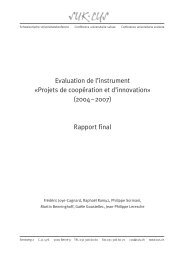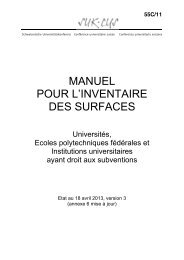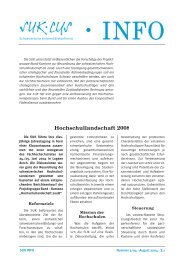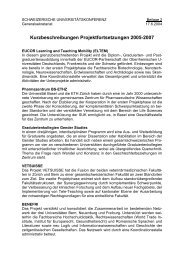Evaluation of the Swiss Virtual Campus - Schweizerische ...
Evaluation of the Swiss Virtual Campus - Schweizerische ...
Evaluation of the Swiss Virtual Campus - Schweizerische ...
You also want an ePaper? Increase the reach of your titles
YUMPU automatically turns print PDFs into web optimized ePapers that Google loves.
SVC Final <strong>Evaluation</strong>. Background Report Lepori and Probst<br />
partners no longer<br />
interested<br />
retirement <strong>of</strong> key<br />
people<br />
missing integration<br />
financial reasons<br />
Figure 13. Risk factors<br />
N = 79<br />
0% 20% 40% 60% 80% 100%<br />
very likely likely moderately likely not likely<br />
In our sample, <strong>the</strong> risk <strong>of</strong> a close-down created by financial reasons is perceived most seriously<br />
by <strong>the</strong> 2 nd series projects (7 out <strong>of</strong> 10 see it as very likely, 1 as likely), while it is estimated<br />
lowest by <strong>the</strong> 1 st series projects (1 out <strong>of</strong> 14 very likely, 3 likely). In <strong>the</strong> 3 rd and 4 th series (both<br />
maintenance and production), around half <strong>of</strong> <strong>the</strong> projects sees this possibility as very likely or<br />
likely. Also <strong>the</strong> retirement <strong>of</strong> key people is perceived as <strong>the</strong> most serious risk factor by 2 nd series<br />
projects (3 out <strong>of</strong> 10 very likely, 4 likely). This risk is perceived lowest by <strong>the</strong> 1 st (4 out <strong>of</strong> 14<br />
likely/very likely) and 4 th series (8 out <strong>of</strong> 28). 11 out <strong>of</strong> <strong>the</strong> 19 projects stating that retirement <strong>of</strong><br />
key people is not likely to be a factor for closing down <strong>the</strong> project are from <strong>the</strong> 4 th series.<br />
4.6 Final appreciation<br />
The picture given by <strong>the</strong> respondents <strong>of</strong> our questionnaire looks, overall, very positive. Most<br />
projects are used in regular activities, even if <strong>the</strong>y have been developed some years ago, and<br />
are expected to continue to be used. Collaboration with <strong>the</strong> CCSP is generally appreciated –<br />
even if <strong>the</strong>re are some cases where this collaboration does not exist or is ra<strong>the</strong>r limited. This<br />
impression <strong>of</strong> varying degrees <strong>of</strong> collaboration was also perceived during <strong>the</strong> monitoring visits.<br />
There are projects that have developed <strong>the</strong>ir own technical and didactical competences, while in<br />
o<strong>the</strong>r cases <strong>the</strong> development <strong>of</strong> projects is done in very close interaction with <strong>the</strong> CCSP – in<br />
extreme cases, <strong>the</strong> project leader is part <strong>of</strong> (or leader <strong>of</strong>) <strong>the</strong> CCSP. Even if this was not directly<br />
a topic <strong>of</strong> <strong>the</strong> evaluation, one should also consider that a significant number <strong>of</strong> SVC projects<br />
won international prizes and awards, including two winners <strong>of</strong> <strong>the</strong> MEDIDA Prix (2003 and<br />
2006) and many participated in <strong>the</strong> final round <strong>of</strong> prizes like MEDIDA Prix, Multimedia Transfer<br />
and EASA award.<br />
The results from <strong>the</strong> questionnaires do not show many differences between projects in <strong>the</strong><br />
production and those in <strong>the</strong> maintenance phase. One difference that emerged was that<br />
maintenance projects were used more <strong>of</strong>ten as – mandatory or optional – standalone courses<br />
than those still in <strong>the</strong> production phase; this might be related to <strong>the</strong> larger size <strong>of</strong> 1 st and 2 nd<br />
series projects.<br />
It emerged in several monitoring visits that collaboration in large teams is a ra<strong>the</strong>r big challenge<br />
– but, however, more than 4/5 <strong>of</strong> <strong>the</strong> projects sees <strong>the</strong> network and collaborations as a<br />
significant added value in <strong>the</strong> project. In several cases, collaboration also goes beyond <strong>the</strong> SVC<br />
project. The lower number <strong>of</strong> project partners requested in <strong>the</strong> 3 rd and 4 th series, though, does<br />
45










